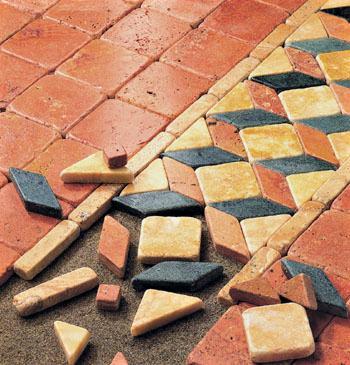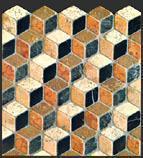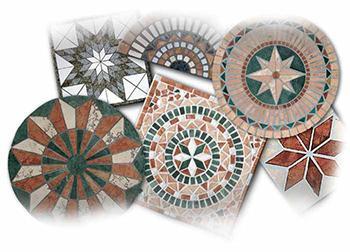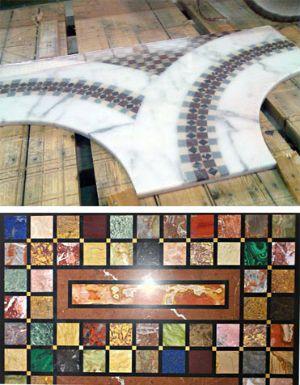Opus Sectile
Post from EditorialsFloors of natural stones and marbles cut according to geometric shapes and combined to make precise designs: an old technique but still very current.
Opus Sectile in the past
 It is an ancient technique, and very refined: the Romans called it opus sectile and used it on a large scale in the richest mansions in the ultra-luxurious imperial baths and palaces of power.
It is an ancient technique, and very refined: the Romans called it opus sectile and used it on a large scale in the richest mansions in the ultra-luxurious imperial baths and palaces of power.
The methods of implementation and the formal rules are conceptually simple, but very difficult for the executive skills required for the workers:
thin slabs of marble sectilia these were in fact cut into geometric shapes more or less complex, and subsequently matched to form a beautiful decorative motifs made of circles, squares, triangles, Greek frets or weaves of various types. The refined combination of different designs, and the contrast between the colors and the grain of the many types of stone then known, perhaps imported from distant provinces with long and dangerous journeys, made therefore of the opus sectile one of the most popular status symbol of the aristocracy: in fact, the more marbles and granites were rare (and therefore expensive), the more the customers was able to show off their wealth and prestige. Some types of stone, such as the red porphyry from Egypt, were in fact reserved to the Emperor, and only widely used in buildings occupied by him or commissioned: for example, it is known that the large gymnasium discovery of the Baths of Caracalla (built by this emperor, subsequently donated to the people of Rome and remained in operation for about three centuries), which formerly showed a very rich and colorful floor consists of a checkerboard of marble.
The refined combination of different designs, and the contrast between the colors and the grain of the many types of stone then known, perhaps imported from distant provinces with long and dangerous journeys, made therefore of the opus sectile one of the most popular status symbol of the aristocracy: in fact, the more marbles and granites were rare (and therefore expensive), the more the customers was able to show off their wealth and prestige. Some types of stone, such as the red porphyry from Egypt, were in fact reserved to the Emperor, and only widely used in buildings occupied by him or commissioned: for example, it is known that the large gymnasium discovery of the Baths of Caracalla (built by this emperor, subsequently donated to the people of Rome and remained in operation for about three centuries), which formerly showed a very rich and colorful floor consists of a checkerboard of marble.
Other - valuable - examples of this technique came from many domus in Pompeii and Herculaneum, where the center of the floors of the representative rooms, especially if made of materials not particularly luxurious as simple mosaics of white tesserae of earthenware or opus signinum, they were embedded with precious decorative boxes called emblemata: often made out of the site of assemblage in specialized shops or even imported from distant provinces, showed a very varied figurative repertoire, mainly made ??up of geometric motifs, plants, friezes or figurative scenes. Later, after the fall of the Roman Empire, the opus sectile was not lost, but was in fact recovered and refined by the Roman marble, reaching perfection in the twelfth and thirteenth centuries by the so-called Masters Cosmati: their floors (visible in many churches in central and southern Italy dating from this period, such as Santa Maria in Cosmedin in Rome or the Pisa Cathedral) in fact it seems real embroidery, with the typical sequences of large circles (called guilloche) bordered by wide bands variously intertwined.
Later, after the fall of the Roman Empire, the opus sectile was not lost, but was in fact recovered and refined by the Roman marble, reaching perfection in the twelfth and thirteenth centuries by the so-called Masters Cosmati: their floors (visible in many churches in central and southern Italy dating from this period, such as Santa Maria in Cosmedin in Rome or the Pisa Cathedral) in fact it seems real embroidery, with the typical sequences of large circles (called guilloche) bordered by wide bands variously intertwined. Instead, since the Renaissance, especially in the Florence of the sixteenth century developed the so-called commesso or Florentine mosaic, a variant of the opus sectile that favors depictions of landscapes, figures and floral motifs to create paintings and decorative panels, objects use (vases, boxes), furniture and liturgical furnishings (including, for example, altars, altar panels and balustrades).
Instead, since the Renaissance, especially in the Florence of the sixteenth century developed the so-called commesso or Florentine mosaic, a variant of the opus sectile that favors depictions of landscapes, figures and floral motifs to create paintings and decorative panels, objects use (vases, boxes), furniture and liturgical furnishings (including, for example, altars, altar panels and balustrades).
At the time of the Grand Tour (XVIII-XIX centuries) in Rome finally became widespread (and became a popular souvenir) pieces of furniture and stone tables that had, embedded in the top, like a sample, various types of stones and rare marbles, with a highly decorative effect.
Opus Sectile nowadays
 And now, thanks to some very well established companies in the processing of marble, this age-old tradition, with its colors and its suggestions, it can enter into your houses, giving it a unique and irresistible charm. In the company's vast catalog I Ciottoli di Marmo by Gaiti Gianni there are in fact very decorative motifs known in ancient Pompeii, such as the interesting optical illusion of these prospective cubes or this refined border, and their modern reinterpretation, among them stands out the incredible reproduction of a real carpet complete with fringe.
And now, thanks to some very well established companies in the processing of marble, this age-old tradition, with its colors and its suggestions, it can enter into your houses, giving it a unique and irresistible charm. In the company's vast catalog I Ciottoli di Marmo by Gaiti Gianni there are in fact very decorative motifs known in ancient Pompeii, such as the interesting optical illusion of these prospective cubes or this refined border, and their modern reinterpretation, among them stands out the incredible reproduction of a real carpet complete with fringe.
If you prefer to adorn the threshold of your home (or your shop) in a particular way, the catalog company SIPRA Marmi is the place for you, and includes many examples of rose windows and marble mosaics, stones or glass square , rectangular or circular, obviously inspired by the emblemata in Pompeii.
If finally, long for showing a floor in cosmatesque style or you want a table-sample, but without contacting an antique dealer, the Company Marcello Cattaneo can easily solve your every need, as demonstrated by the partial reproduction of a guilloche pattern or this panel with various kinds of stones, including the rare and precious malachite unmistakable bright green color.
79809 REGISTERED USERS










